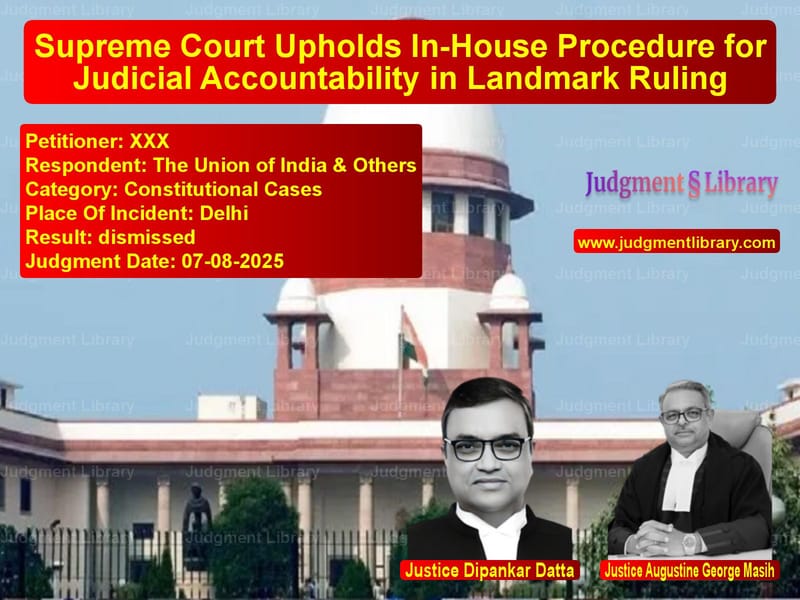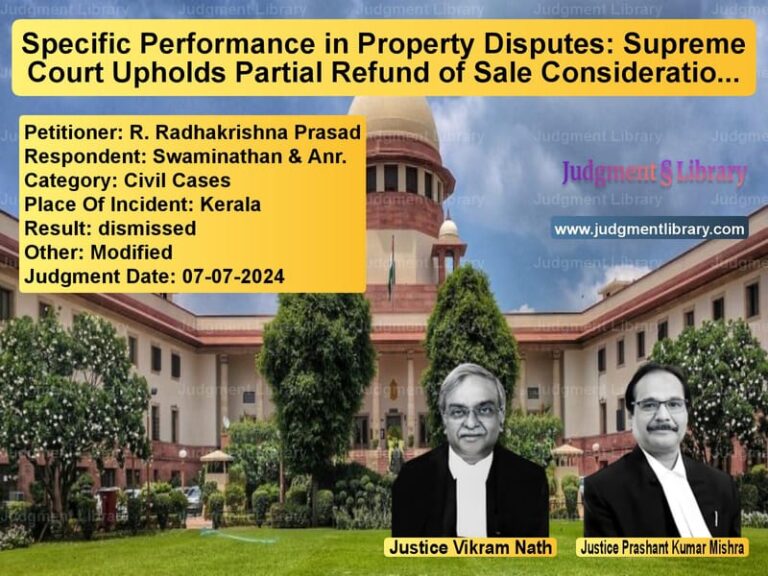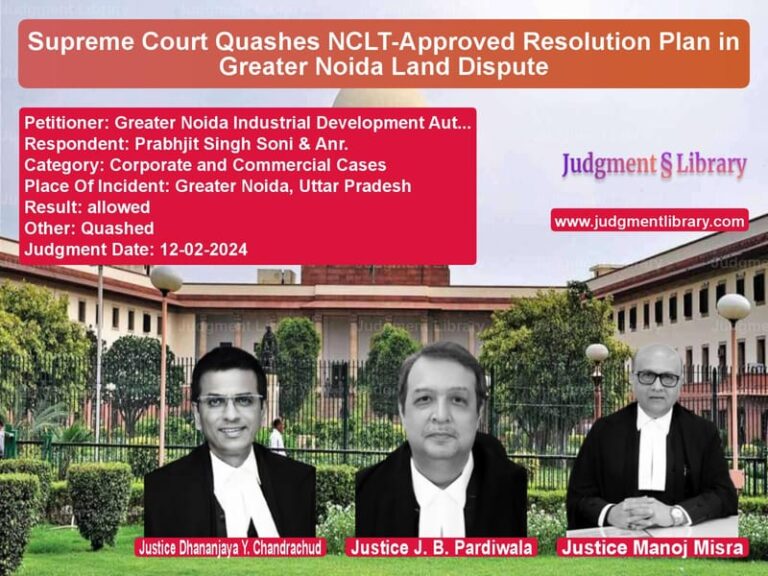Supreme Court Upholds In-House Procedure for Judicial Accountability in Landmark Ruling
In a landmark judgment that reinforces the mechanisms for maintaining judicial integrity, the Supreme Court of India recently dismissed a writ petition challenging the constitutional validity of the “In-house Procedure” used for investigating complaints against judges. The case involved a High Court judge identified as ‘XXX’ who faced allegations of misconduct after burnt currency notes were discovered in a store-room at his official residence during a fire incident. This ruling represents a significant moment in India’s judicial history, addressing the delicate balance between judicial independence and accountability.
The matter came before the Supreme Court through a writ petition filed under Article 32 of the Constitution by the aggrieved judge, who sought protection of his fundamental rights under Articles 14 and 21. The petition challenged specific provisions of the In-house Procedure, particularly paragraphs 5(b) and 7(ii), which allow a committee to recommend initiation of removal proceedings and enable the Chief Justice of India to forward such recommendations to the President and Prime Minister.
The case originated from a fire incident that occurred at the store-room of the petitioner’s official bungalow while he was serving as a judge of the Delhi High Court. During the firefighting operations, burnt currency notes were discovered, raising suspicions about the judge’s conduct. This discovery triggered the In-house Procedure, leading to the constitution of a three-member committee by the Chief Justice of India to investigate the matter.
Senior Advocate Mr. Kapil Sibal, representing the petitioner, advanced several constitutional arguments challenging the procedure. He contended that “the Petitioner is aggrieved by the PROCEDURE to the extent it permits the Committee to opine as to whether the misconduct calls for initiation of proceedings for removal. He is also aggrieved because the PROCEDURE permits the CJI to intimate the President and the Prime Minister that the misconduct warrants initiation of proceedings for removal.”
Mr. Sibal argued that Articles 124 and 218 of the Constitution, read with the Judges (Inquiry) Act, 1968, constitute a complete code for the removal of judges, and any parallel procedure would be unconstitutional. He emphasized that “the tenure of a High Court Judge is protected by the Constitution, and such a Judge is subject to the Constitution and the Constitution alone.”
The petitioner’s counsel further contended that the procedure lacked essential safeguards available under the Judges (Inquiry) Act, such as framing of charges, presentation of evidence, cross-examination of witnesses, and strict proof requirements. He argued that “the PROCEDURE contemplates such procedure as may be appropriate in the facts of a case. The PROCEDURE does not obligate the Committee to follow the codified or defined rules of evidence and permits the Committee to adopt such procedure as necessary, potentially leading to holding a Judge guilty, not just of serious misconduct but also calling for his removal.”
Mr. Sibal also raised concerns about the publication of photographs and video footage related to the incident on the Supreme Court’s website, arguing that this action had effectively convicted the petitioner in the public eye even before any formal inquiry. He relied heavily on the Constitution Bench decision in Sub-Committee on Judicial Accountability v. Union of India to support his contention that the Chief Justice of India has no disciplinary control over High Court judges.
The Supreme Court bench comprising Justices Dipankar Datta and Augustine George Masih delivered a comprehensive judgment addressing all these contentions. The Court began by examining the constitutional framework for judicial removal, noting that “a Judge of a High Court cannot be removed from office except on the ground of proved misbehaviour or proved incapacity.”
The Court traced the historical development of the In-house Procedure, noting that it emerged from the decision in C. Ravichandran Iyer v. Justice A.M. Bhattacharjee, where the Supreme Court recognized the “yawning gap between proved misbehaviour and bad conduct inconsistent with the high office” of a judge. The Court quoted extensively from this precedent, which stated that “the yawning gap between proved misbehaviour and bad conduct inconsistent with the high office on the part of a non-cooperating Judge/Chief Justice of a High Court could be disciplined by self-regulation through in-house procedure. This in-house procedure would fill in the constitutional gap and would yield salutary effect.”
The Supreme Court emphasized the evolving nature of constitutional interpretation, stating that “the Constitution is not a static document. Constitutional Courts are obligated to interpret the Constitution in the light of evolving standards and institutional needs.” This recognition of the dynamic nature of constitutional interpretation formed a crucial basis for upholding the procedure.
Addressing the petitioner’s challenge to the Chief Justice of India’s role, the Court observed that “while the CJI is no doubt primus inter pares – first among equals – and also does not exercise powers of superintendence over the High Courts and the Judges of the High Court, nonetheless, the CJI bears a significant moral responsibility as the foremost judicial officer to ensure that the judiciary of the country functions in a transparent, efficient and constitutionally appropriate manner.”
The Court provided important clarification about the nature of the in-house inquiry, describing it as “a fact-finding inquiry as distinguished from a guilt-finding inquiry; and it is, therefore, akin to a preliminary inquiry that precedes regular disciplinary proceedings against a delinquent employee.” This characterization helped distinguish the procedure from the formal removal process under the Constitution.
One of the significant aspects of the judgment was its interpretation of the Judges (Protection) Act, 1985. The Court held that Section 3(2) of this Act, which allows the Supreme Court to take action against judges, provides statutory recognition to the In-house Procedure. The Court stated that “the term ‘otherwise’ read in conjunction with ‘such action’, appearing in the said sub-section, is wide enough to encompass measures that the PROCEDURE contemplates.”
The Court also addressed the petitioner’s conduct during the proceedings, noting that he had participated in the inquiry without raising objections at the appropriate time. The judgment referenced the principle from P.D. Dinakaran (1) v. Judges Inquiry Committee that “the petitioner’s knowledgeable silence… militates against the bona fides of his objection.”
Regarding the publication of incriminating material, the Court acknowledged that “uploading of the photographs/video footage on the website of this Court cannot be viewed as a necessary requirement of the ‘In-house Procedure’ and, thus, approved.” However, the Court noted that the petitioner had not challenged this aspect promptly.
The Supreme Court ultimately rejected all the petitioner’s contentions, holding that the In-house Procedure “has its roots in the law declared by this Court under Article 141 of the Constitution.” The Court emphasized that the procedure serves the crucial purpose of maintaining institutional integrity while respecting the constitutional framework for judicial removal.
In its concluding observations, the Court highlighted the delicate balance between judicial independence and accountability: “The judiciary in India is characterised by judicial independence; however, judicial independence signifies flexibility of judicial thought and the freedom to adjudicate without external and internal pressure, and not unfettered liberty to act as one might wish. Just as judicial independence is fundamental, so too is judicial accountability; compromising one compromises the other.”
This judgment represents a significant affirmation of the judiciary’s ability to self-regulate while maintaining the constitutional balance of powers. By upholding the In-house Procedure, the Supreme Court has reinforced the mechanisms through which the Indian judiciary addresses issues of judicial conduct, ensuring that the institution maintains public confidence while respecting the constitutional framework for judicial appointments and removals.
The ruling acknowledges that while the Constitution provides a formal mechanism for removal through parliamentary impeachment, the In-house Procedure serves the complementary purpose of addressing conduct issues that may not necessarily rise to the level requiring formal removal proceedings. This balanced approach recognizes the practical realities of maintaining judicial standards while preserving the independence of the judiciary.
Petitioner Name: XXX.Respondent Name: The Union of India & Others.Judgment By: Justice Dipankar Datta, Justice Augustine George Masih.Place Of Incident: Delhi.Judgment Date: 07-08-2025.Result: dismissed.
Don’t miss out on the full details! Download the complete judgment in PDF format below and gain valuable insights instantly!
Download Judgment: xxx-vs-the-union-of-india-&-supreme-court-of-india-judgment-dated-07-08-2025.pdf
Directly Download Judgment: Directly download this Judgment
See all petitions in Constitution Interpretation
See all petitions in Separation of Powers
See all petitions in Legal Malpractice
See all petitions in Fundamental Rights
See all petitions in Judgment by Dipankar Datta
See all petitions in Judgment by Augustine George Masih
See all petitions in dismissed
See all petitions in supreme court of India judgments August 2025
See all petitions in 2025 judgments
See all posts in Constitutional Cases Category
See all allowed petitions in Constitutional Cases Category
See all Dismissed petitions in Constitutional Cases Category
See all partially allowed petitions in Constitutional Cases Category







